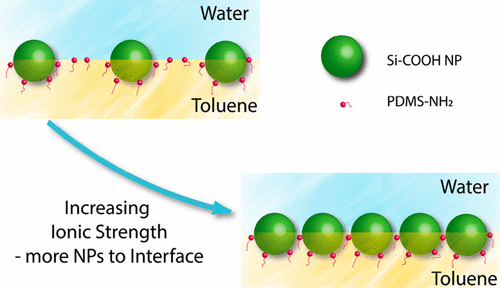当前位置:
X-MOL 学术
›
Nano Lett.
›
论文详情
Our official English website, www.x-mol.net, welcomes your
feedback! (Note: you will need to create a separate account there.)
Fine-Tuning Nanoparticle Packing at Water–Oil Interfaces Using Ionic Strength
Nano Letters ( IF 9.6 ) Pub Date : 2017-09-15 00:00:00 , DOI: 10.1021/acs.nanolett.7b03462 Yu Chai , Alysia Lukito , Yufeng Jiang , Paul D. Ashby , Thomas P. Russell 1, 2
Nano Letters ( IF 9.6 ) Pub Date : 2017-09-15 00:00:00 , DOI: 10.1021/acs.nanolett.7b03462 Yu Chai , Alysia Lukito , Yufeng Jiang , Paul D. Ashby , Thomas P. Russell 1, 2
Affiliation

|
Nanoparticle-surfactants (NPSs) assembled at water–oil interfaces can significantly lower the interfacial tension and can be used to stabilize liquids. Knowing the formation and assembly and actively tuning the packing of these NPSs is of significant fundamental interest for the interfacial behavior of nanoparticles and of interest for water purification, drug encapsulation, enhanced oil recovery, and innovative energy transduction applications. Here, we demonstrate by means of interfacial tension measurements the high ionic strength helps the adsorption of NPSs to the water–oil interface leading to a denser packing of NPSs at the interface. With the reduction of interfacial area, the phase transitions from a “gas”-like to “liquid” to “solid” states of NPSs in two dimensions are observed. Finally, we provide the first in situ real-space imaging of NPSs at the water–oil interface by atomic force microcopy.
中文翻译:

利用离子强度在水-油界面处微调纳米颗粒堆积
在水-油界面处组装的纳米表面活性剂(NPS)可以显着降低界面张力,并可用于稳定液体。知道这些NPS的形成和组装并积极调整其堆积对于纳米粒子的界面行为具有重大的根本意义,并且对于水净化,药物封装,提高的采油率和创新的能量转换应用也具有重要意义。在这里,我们通过界面张力测量证明了高离子强度有助于NPS吸附到水-油界面上,从而导致NPS在界面处更密集地堆积。随着界面面积的减小,在二维中观察到从NPS的“气态”到“液态”到“固态”的相变。最后,我们提供第一个通过原子力显微镜在水-油界面处对NPS进行原位真实空间成像。
更新日期:2017-09-15
中文翻译:

利用离子强度在水-油界面处微调纳米颗粒堆积
在水-油界面处组装的纳米表面活性剂(NPS)可以显着降低界面张力,并可用于稳定液体。知道这些NPS的形成和组装并积极调整其堆积对于纳米粒子的界面行为具有重大的根本意义,并且对于水净化,药物封装,提高的采油率和创新的能量转换应用也具有重要意义。在这里,我们通过界面张力测量证明了高离子强度有助于NPS吸附到水-油界面上,从而导致NPS在界面处更密集地堆积。随着界面面积的减小,在二维中观察到从NPS的“气态”到“液态”到“固态”的相变。最后,我们提供第一个通过原子力显微镜在水-油界面处对NPS进行原位真实空间成像。











































 京公网安备 11010802027423号
京公网安备 11010802027423号